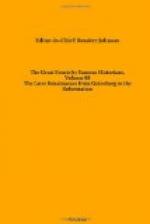Leo X died on December 1, 1521, a year after Raphael. His successor, the humble and austere Adrian VI, knew nothing about pictures, except those of Van Eyck and Albert Duerer. His simple manners formed a striking contrast to the ostentatious habits of Leo. During his pontificate, all the great works were stopped at Rome and slackened at Florence. While Michelangelo was obscurely working at the library of San Lorenzo, the great age of art was drawing to its close; Raphael and Leonardo were dead, and their pupils were already hurrying on to a rapid decadence.
Characters were beginning to decline at the same time that talent did, and Michelangelo, who, as it were, opened this grand era, was destined to survive alone, like those lofty summits that first receive the morning light, and which are still lit up while all around has grown obscure and night is already profound.
BALBOA DISCOVERS THE PACIFIC
A.D. 1513
MANUEL JOSE QUINTANA
Vasco Nunez de Balboa, the Spanish soldier and discoverer of the Pacific Ocean, was born in 1475, and died near Darien, the scene of his principal achievement, probably in 1517. Unfairly charged with conspiracy, after rendering great services to his country, he was beheaded just as he was completing preparations to explore the “South Sea,” as he named the ocean which he had discovered.
He first went to Darien from Espanola (Haiti) in 1510, promoted a settlement, and was made its alcalde. In 1512 Pasamonte, king’s treasurer at Santo Domingo, commissioned him as governor. Balboa undertook many explorations, and was usually on friendly terms with the Indians, who told him of a great sea lying to the south, and of a country (Peru) rich in gold, far down the coast. He set out from Darien September 1, 1513, to discover the great sea and the country of which he thus heard. He had conquered the Indian king Careta, whose friendship he gained and whose daughter he married. He went by sea to his father-in-law’s territory, and taking with him some of the King’s Indians he moved into the territory of the cacique Ponca, an enemy of Careta.
Quintana, whose account follows, is the favorite historian of this expedition. His Lives of Celebrated Spaniards is regarded as one of the classics of Spanish prose literature.
Ponca, not daring to await the coming of the allies, took refuge in the mountains, abandoning his land to the ravage and ruin prepared for it by the Indians and Spaniards. Balboa, however, did not pursue his success further at present; leaving to the future the conquest, or, as he termed it, the “pacification” of the interior, he returned to the coast, where it was more for the advantage, security, and subsistence of the colony to have his friends or his vassals stationed.




